Norway’s house price rises decelerating
After a decade of uninterrupted house price rises Norway’s housing market is stabilizing, due to stricter mortgage rulesand rising interest rates.

The nationwide house price index rose by a modest 2.35% during the year to Q3 2019, according to Statistics Norway. When adjusted for inflation, Norwegian house prices increased by a meagre 0.69% y-o-y in Q3 2019. During the last quarter nationwide house prices actually fell by 0.8% (-1.1% inflation-adjusted).
Oslo including Bærum had the highest house price increasesin the country, at 3.7% annually (2.02% inflation-adjusted) during the year to Q3 2019, a slight slowdown from a 4.01% growth (-1.93% inflation-adjusted) during the same period in 2018.
During the year to Q3 2019:
- In Bergen, the house price index rose by 2.22% y-o-y (0.57% inflation-adjusted), up from a 0.88% annual rise in Q3 2018. But during the latest quarter, house prices fell by 0.94% from the previous quarter (-1.29% inflation-adjusted).
- In Trondheim, house prices rose by 1.72% y-o-y (0.08% inflation-adjusted), in contrast with a 0.27% drop in Q3 2018. In Q3 2019, house prices increased 0.9% q-o-q (0.54% inflation-adjusted).
- In Stavanger, house prices rose by 0.92% y-o-y (-0.71% inflation-adjusted), compared to a 1.14% annual increase in Q3 2018. During the latest quarter, local house prices fell by 2.28% q-o-q (-2.63% inflation-adjusted).
Of the country’s regions, Sør-Østlandet had the highest annual price increase at a modest 3.12% (1.45% inflation-adjusted), followed by Akershus excluding Bærum (2.76%) and Agder and Rogaland excluding Stavanger (1.98%).There were minimal annual price hikes in Nord-Norge (1.37%), Vestlandet excluding Bergen (1.23%), and Trøndelag exluding Trondheim (0.63%). On the other hand, house prices were unchanged in Hedmark and Oppland.
Demand continues to rise. Residential property sales in Norway rose by 4.6% to 65,214 units in the first three quarters of 2019, compared to the same period in 2018, according to Statistics Norway. In Oslo, sales soared by 23.5%.
Despite this, construction remains weak. Dwelling completions fell by 5.4% y-o-y in the first eleven months of 2019 while starts rose by 3.7%, according to Statistics Norway.
In 2019, Norway’s mainland GDP, which excludes the volatile oil and shipping sectors, was estimated to have expanded by 2.5%, following 2.5% in 2018, and 2.4% in 2017, according to Norges Bank.
Slower growth ahead is expected - GDP growth is likely to slow to 2% in 2020 and to 1.7% in 2021, according to Organisation for Economic Cooperation and Development (OECD). Statistics Norway forecasts 2.4% growth in 2020 and 1.9% in 2021.
Anyone can own, occupy, and invest in real estate in Norway.
Norway´s long house price boom
Norway is no stranger to rapid house price increases. Since 1990, house prices have risen by more than 10% annually, at least in nominal terms, during eight different periods:
- Q1 1994 - Q4 1994: average y-o-y growth of 13.3% (11.8% in real terms)
- Q4 1996 - Q3 1998: 12% (9.4% real)
- Q3 1999 - Q3 2000: 16.8% (13.6% real)
- Q2 2004 - Q4 2004: 10.4% (9.2% real)
- Q1 2006 - Q3 2007: 14% (12.3% real)
- Q4 2009 - Q1 2010: 11.2% (8.8% real)
- Q1 2010 - Q2 2013: 25.9% (20.4% real)
- Q4 2013 – Q3 2019: 31.5% (16.3% real)
Causes of these strong house price increases:
- strong economic growth
- low interest rates
Annual price falls were observed only in four periods:
- Q1 1993 - Q2 1993: -3.2% (-5.6% in inflation adjusted-terms)
- Q2 2003: -1.1% (-3.2% real)
- Q3 2008 - Q2 2009: -4% (-7.2% real)
- Q1 2018: -1.1% (-5.3% real)
Prices of detached houses in Oslo rose by 184% between 2002 and 2018, to NOK 58,761 (US$ 6,652) per sq. m. In Norway as a whole, detached house pricesrose 121% over the same period.
A detached house in Norway cost an average NOK 24,917 (US$ 2,821) per square metre (sq. m.) in 2018, up 1.5% from a year earlier, according to Statistics Norway.
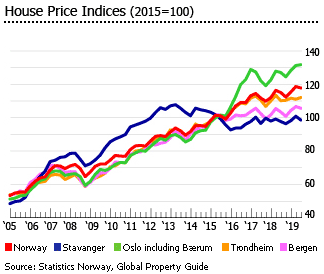
Row homes’ average prices increased 1.4% y-o-y to NOK 33,252 (US$ 3,764) per sq. m. in 2018.
Apartments’ average prices were up 1.2% y-o-y to NOK 53,404 (US$ 6,045) per sq. m.
Demand remains strong
Residential property sales rose by 4.6% to 65,214 units from a year earlierin the first three quarters of 2019, according to Statistics Norway. In Oslo, sales soared by 23.5% to 6,613 units over the same period.

By property type:
- Detached houses´ sales rose 4.8% y-o-y to 26,451 houses in the first three quarters of 2019
- Multi-unit dwellings´ sales increased 3.7% y-o-y to 23,575 units in the first three quarters of 2019
- Row houses´ sales fell slightly by 1.8% y-o-y to 5,006 units over the same period
Strict mortgage rules are slowing the housing market
To curb rapidly rising house prices the government implemented stricter mortgage rules on January 1, 2017. The rules include:
- A borrowing cap less than five times the borrower’s gross income;
- Mortgages will last a shorter time;
- In Oslo, an equity requirement of at least 40% for secondary home buyers, as opposed to the 15% equity for first-time buyers;
- Lenders should make allowance for an interest rate increase of 5 percentage points when assessing a borrower’s debt-servicing ability.
The restrictions will be in force at least until the end of December 2020.
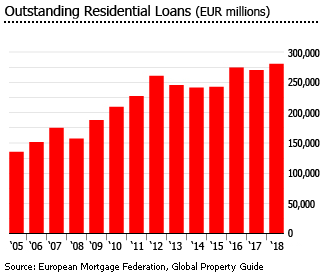
Norway has the third-highest level of debt-to-income among OECD nations behind Denmark and the Netherlands, at more than 231% - almost double its level in 1995. “The high debt of Norwegian households still pose significant risk to the economy and to jobs,” said the Finance Ministry.
Norway’s mortgage market has grown from around 40% of GDP in 2000 to almost 82% of GDP in 2016, but shrunk to 76.1% of GDP last year, according to the European Mortgage Federation’s Hypostat 2019 report. DNB, Nordea and Danske Bank are among the country’s top mortgage lenders.
Interest rates rising gradually
Housing loan rates are now rising. In October 2019, the average interest rate for new housing loans increased to 2.97%, from 2.55% a year earlier and 2.45% two years ago, according to Statistics Norway. Over the same period:
- Floating interest rate housing loans (Up to 3 months): 2.98%, up from 2.54% a year earlier and 2.45% two years ago
- Fixed interest rate housing loans (More than 3 months): 2.76%, slightly down from 2.84% a year earlier but up from 2.42% two years ago
- Fixed interest rate housing loans (1-3 years): 2.68%, up from 2.59% a year ago and 2.23% two years ago
- Fixed interest rate housing loans (3-5 years): 2.77%, down from 2.93% in the previous year but up from 2.63% two year ago
- Fixed interest rate housing loans (Over 5 years): 2.82%, down from 3.3% a year earlier and 3.12% two years ago
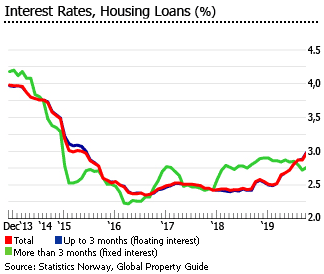
This follows four rate hikes to 1.5% by Norges Banksince September 2018.
Rents lag house prices in Oslo
Is Norway experiencing a housing bubble? Normally there is a clear pattern to housing bubbles, with house price rises greatly outpacing rent rises during the boom. In Norway, however, while the house price index (HPI) rose by about 33% from 2012 to 2019, the average monthly rent rose between 48.9% for one-bedroom dwellings and 40.6% for dwellings with five or more bedrooms, based on the figures from Statistics Norway.
In Oslo and its neighbouring municipality Bærum, however, house prices areoutpacing rents. Oslo’s HPI rose by 53% from 2012 to 2019, while average monthly rents rose by less.
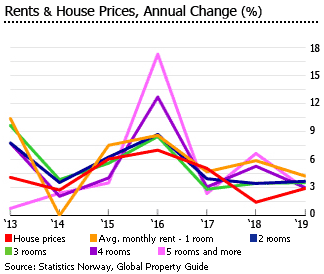
There are two main reasons why house prices are outpacing rental rises in Oslo:
[1] According to Morgen Granhaug of M3 Rental, many investors have purchased apartments to rent out, which keeps rent prices down.
[2] Owning a house is relatively cheaper than renting a property, argues Nordea’s chief economist Kjetil Olsen and chief analyst Erik Bruce, partly due to the strong tax support for owning. He argues that it still makes sense to purchase a 30 square metres residence for NOK 3 million (US$ 339,592), rather than renting the same place.
Owner occupancy is strongly subsidized by the state
State policy has had a strong impact on housing preferences in Norway:
- Preferential interest rates are offered to households through the State Housing Bank.
- Buyers can purchase municipal land at subsidized prices.
- Owner-occupiers get tax relief on mortgage interest payments.
- Owner-occupied housing is taxed at a lower effective rate than rental housing.
- Owner-occupied dwellings are capital gains tax exempt.
The long-term impact of all these measures has been a massive shift in the structure of Norway’s housing market. In 1920 47% of Norway’s households were renters. But by early-2019 only 17.9% rented, while around 70.6% were freeholders and 11.6% shareholders.
Oslo has the lowest portion of homeowners at about 42.2%, while 25.8% of households in Oslo rent, with shareholders 32.1% of total households.
At the same time, there is a consensus that the free market does not provide sufficient housing for the poor. Social rental housing made up around 15% of total rental stock in Norway.
Rents continue to rise modestly
In 2019, the average monthly rent for two-bedroom dwellings rose by 3.66% y-o-y to NOK 9,060 (US$ 1,026) while rents for three-bedroom dwellings increased 3.52% y-o-y to NOK 10,580 (US$ 1,198), according to Statistics Norway.
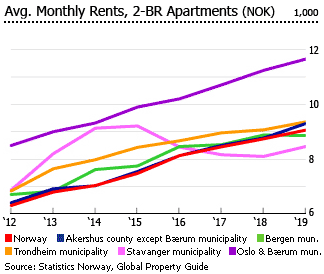
In 2019:
- Two-room Oslo (including Bærum) dwellings had an average monthly rent of NOK 11,650 (US$ 1,319) in 2019, while three rooms cost NOK 14,100 (US$ 1,596) monthly.
- In the municipality of Trondheim, two and three-room dwellings rent for NOK 9,360 (US$ 1,060) and NOK 11,330 (US$ 1,283), respectively.
- In Bergen, two and three-room dwellings rent for NOK 8,860 (US$ 1,003) and NOK 10,710 (US$ 1,212) per month, respectively.
- In Stavanger, rents averaged NOK 8,460 (US$ 958) per month for two-room dwellings and NOK 10,500 (US$ 1,189) per month for three-room dwellings.
- In Akershus county (except Bærum), two-room dwellings had an average monthly rent of NOK 9,300 (US$ 1,053) while three rooms cost NOK 10,600 (US$ 1,200) per month.
Norway has problems of under-supply
The IMF has recommended that the country should relax constraints on new property construction to rein in rapid house price rises.
"There’s an upward trend in housing starts, but Oslo has a need for even stronger growth," says Norwegian Home Builders’ Association (NHBA) Chief Executive Per Jaeger. "That’s our challenge."
The increase in dwelling starts and completions in Norway has been modest in comparison to countries such as Ireland or Spain, despite the house price boom. Dwelling starts averaged 31,000 during the boom years from 2004 to 2007, then fell to 21,000 units annually from 2008 to 2010.

They then rose again to an annual 33,700 units from 2016 to 2018. Completions followed a similar pattern.
Dwelling starts rose by 3.7% to 30,131 units In the first eleven months of 2019, according to Statistics Norway, which completions fell by 5.4% y-o-y to 27,861 units.
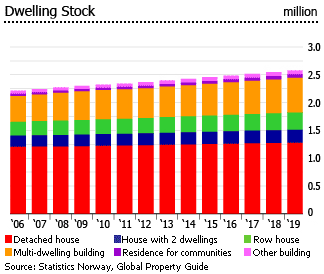
There were 2,581,155 dwellings in Norway in 2019, up by 1.3% from a year earlier. About half were detached houses.
Modest economic growth; low employment
Norway’s mainland GDP, which excludes the volatile oil and shipping sectors, expanded by 2.5% in 2019, following growth of 2.5% in 2018, and 2.4% in 2017, according to the central bank.
“Growth in the Norwegian economy has been solid since 2016,” Norges Bank said.“The global upturn, improved cost-competitiveness, and higher oil prices have helped liftactivity, as have low interest rates.”
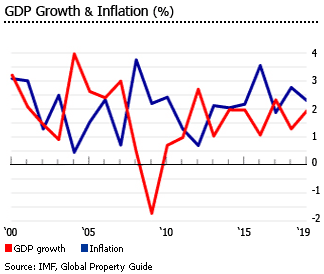
Norway’s petroleum industry is the country’s largest industry, accounting for more than 20% of GDP, and around 47% of exports by value. Norway’s mainland GDP grew by just 0.4% in 2015 and 0.3% in 2016.
Europe’s Brent crude oil spot price averaged US$63.21 per barrel in November 2019, down from 2.4% a year earlier and far below the average price of US$107.64 per barrel from 2011 to 2014.
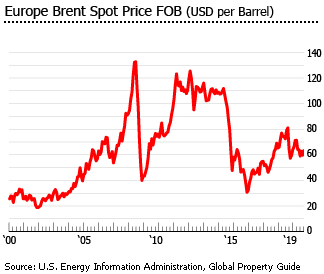
Economic growth is projected to slow again in the next two years, due to a slowdown in global trade and investment, according to the Organisation for Economic Cooperation and Development (OECD). The OECD expects Norway’s mainland GDP to grow by 2% in 2020 and to 1.7% in 2021. This is below the Statistics Norway’s forecast of 2.4% growth in 2020 and 1.9% in 2021.
In the past five years, the Norwegian Krone (NOK) has depreciated by about 10.6% against the euro, from NOK 8.9727 = EUR 1 in December 2014 to NOK 10.0388 = EUR 1 in December 2019.
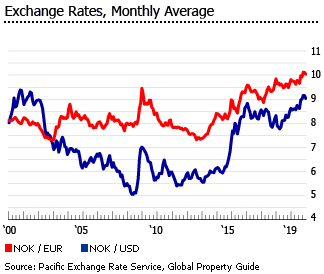
The krone lost 19.4% of its value against the US dollar over the same period, from NOK 7.2787 = USD 1 to NOK 9.0324 = USD 1 last month.
Unemployment was around 3.8% in October 2019, down from 4% a year earlier, according toStatistics Norway.
Inflation was 1.6% in November 2019, sharply down from last year’s 3.5% and well below the Norges Bank’s target of 2%, according to Statistics Norway. Inflation averaged 2.1% from 2009 to 2018.
Sources:
- Price index for existing dwellings (Statistics Norway): https://www.ssb.no/en/statbank/table/07221/tableViewLayout1/
- Prices per square metre of detached houses (Statistics Norway): https://www.ssb.no/en/priser-og-prisindekser/statistikker/kvadenebol
- World Economic Outlook Database, October 2019 (International Monetary Fund): https://www.imf.org/external/pubs/ft/weo/2019/02/weodata/
- Rental market survey (Statistics Norway): https://www.ssb.no/en/statbank/table/09895/tableViewLayout1/
- Interest rates in banks and mortgage companies (Statistics Norway): https://www.ssb.no/en/bank-og-finansmarked/statistikker/renter/maaned
- Changes in the policy rate (Norges Bank): https://www.norges-bank.no/en/topics/Monetary-policy/Policy-rate/Key-policy-rate-Monetary-policy-meetings-and-changes-in-the-policy-rate/
- Policy rate unchanged at 1.50 percent (Norges Bank): https://www.norges-bank.no/en/topics/Monetary-policy/Monetary-policy-meetings/2019/december-2019/
- Building statistics (Statistics Norway): https://www.ssb.no/en/statbank/list/byggeareal
- Dwellings (Statistics Norway): https://www.ssb.no/en/statbank/list/boligstat
- House prices skyrocketing, but dragging in the rental market (Norway Today): https://norwaytoday.info/finance/house-prices-skyrocketing-dragging-rental-market/
- Housing conditions, register-based (Statistics Norway): https://www.ssb.no/en/statbank/table/11038/
- New regulation on requirements for residential mortgage loans (Government.no): https://www.regjeringen.no/en/aktuelt/new-regulation-on-requirements-for-residential-mortgage-loans/id2677835/
- Hypostat 2019: A Review of Europe’s Mortgage and Housing Markets (European Mortgage Federation): https://hypo.org/emf/publications/hypostat/hypostat-2019/
- Norway´s economy to slow as trade, investment falter – OECD (EuroNews): https://www.euronews.com/2019/12/09/norways-economy-to-slow-as-trade-investment-falter-oecd